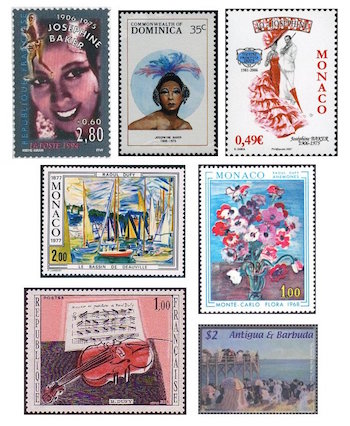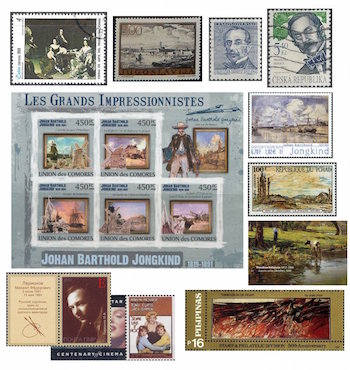The Arts on the Stamps of the World — June 3
An Arts Fuse regular feature: the arts on stamps of the world.

By Doug Briscoe
Josephine Baker is the lead in today’s lineup, which happens to have seven (!) painters waiting in the wings, along with a 19th-century Bohemian composer and Tony Curtis.
Freda Josephine McDonald (3 June 1906 – 12 April 1975) was married at 13, divorced, and married again at 15. That marriage didn’t last long, either, but the young girl kept the name Josephine Baker. That year, 1921, she was working in a vaudeville show in St. Louis; shortly afterward she was in New York City for the Harlem Renaissance and then moved on to Paris, performing at the Champs-Élysées Theater in La Revue Nègre at 19. She was a hit. Her erotic dancing, with a skirt made of artificial bananas, made her famous then and ever after. She acted in a few French films and an Offenbach opéra comique, for which she long and conscientiously prepared. Baker came back to the States for a 1936 revival of the Ziegfeld Follies on Broadway, but critical yawns and blatant racism led her back to France, where she took on French citizenship. An entirely new role awaited her: that of spy. Maintaining the party life when war broke out, she gleaned snippets of information from convivial German officers, Japanese diplomats, and Italian embassy officials. During the Occupation, she lived in the south of France, passing on information to those who could get it to England, sometimes using sheet music marked with invisible ink. For her courageous efforts she was awarded the Croix de guerre. Baker gave the United States another chance in 1951, received glowing reviews this time, and battled against segregation, speaking at the March on Washington. As for her personal life, apart from her four marriages she had affairs with Georges Simenon and Frida Kahlo (whose birthday is next month). Anticipating Brangelina by decades—Angelina Jolie specifically cited her as a role model—Baker adopted twelve children from Morocco, Korea, Japan, Colombia, Finland, France, Israel, Algeria, Côte d’Ivoire, and Venezuela. Late in life she became a Roman Catholic. Her final performance on 8 April 1975, a 50th anniversary revue, was attended by Prince Rainier, Princess Grace, Jacqueline Kennedy Onassis, Sophia Loren, Mick Jagger, Shirley Bassey, Diana Ross, and Liza Minnelli. The great Josephine Baker died peacefully in her bed just four days later. She is honored on stamps from her adopted France, the Dominican Republic, and Monaco.
Raoul Dufy (3 June 1877 – 23 March 1953) is, I think, the most prominent of our painters today, so he’s up next, ahead of four elder artists. Certainly Dufy worked more than in paint, with his designs for theater, ceramics, textiles, furniture, and public spaces as well as his work as a draftsman, printmaker, book illustrator, etc. All his stamps, though, show paintings: two lovely ones from Monaco, The Basin of Deauville (1935) and Anemones (1937), a French one of The Red Violin (actually, I know of two Dufy paintings with this title), and The beach and pier at Trouville (1905) from a sheetlet from Antigua.
Furthest back in time was the Dutchman Willem van Mieris (3 June 1662 – 26 January 1747). He lived all his life in Leiden. His father was a successful genre painter, Frans van Mieris the Elder. Willem also branched out into sculpture. For further study, the English language Wikipedia article is very lengthy, much longer than the corresponding ones in Dutch, French, or German. Hanging in the Havana National Museum, and thus showing up on a Cuban stamp, is Family Reunion, which can’t be dated accurately but is known to have been painted before the turn of the century. (I provide a link, as the image is not of the clearest.) This is the only van Mieris stamp I’m aware of, but you may see much more of his painting—none of his sculptures, alas—at Art UK.

A century later we have Louis-François Cassas (June 3, 1756 – November 1, 1827), who came from central France and was working with his father as a draftsman from the age of fifteen. He was the godson of a marquis and enjoyed many advantages, travelling much in Italy, Constantinople, and the Middle East. (He painted in the Holy Land, too, where he said, “I just got back from the Middle East.”) His work from this region was influential in subsequent European stage designs. Cassas tried his hand at many disciplines, painting, mostly of landscapes, sculpting, architecture, and archaeology, and toward the end of his life was Inspector General at the Gobelin tapestry factory. Again, we have but a single example of his work on a stamp, and that from Yugoslavia—a 1782 etching of the city of Split.
Composer František Škroup (FRAHN-ti-sheck SHKROPE; 3 June 1801 – 7 February 1862) came from a musical family: his father and two brothers were also composers. Besides being a flutist and conductor who led the Czech premières of many works by Wagner and others, he himself wrote a dozen works for the stage, an overture, three string quartets, etc. He also wrote the melody for the Czech national anthem, “Kde domov můj?.” (Where is my home?). This theme, written for incidental music to a comedy in 1834, was also used by Dvořák in his “My Home” Overture. Czechoslovakia issued a stamp on the occasion of the centenary of Škroup’s death, and the Czech Republic issued one in 2001 for the bicentennial of his birth.
Dutch painter and printmaker Johan Barthold Jongkind (3 June 1819 – 9 February 1891) is more broadly featured on stamps of the world, perhaps even to a rather surprising degree. He left his native Netherlands for Paris in 1846, where his work was admired by Baudelaire and Zola, but he suffered from depression and alcoholism. Nevertheless such later figures as Sisley and Monet viewed him as a mentor. Jongkind specialized in harbor views; he would paint outdoors in watercolor and use these canvases as models for his oil paintings. A half dozen of these can be seen (or at least vaguely made out) on the minisheet from the Comoros Islands: on the top row of the sheet, from left, are Honfleur (1865), housed at the Metropolitan Museum in New York, The Statecoach, Faubourg Saint-Jacques (1867), and Une Rue de Nevers (1874); at bottom are Overschie in the Moonlight (1871), Bords de l’Isère (1886), and View from the Quai d’Orsay (1854). The French stamp displays Bateaux à Honfleur à marée basse (1864); and the Chadian one The Pont de Lesdiguieres, near Grenoble (1883). Jongkind also made a portrait of Courbet.

American painter Theodore Robinson (June 3, 1852 – April 2, 1896), born in Vermont, reared in Wisconsin, studied in Chicago and New York and in Paris under Jean-Léon Gérôme. On his return to France some years later he became a close friend of Monet. Robinson was one of the first to bring Impressionism to America. He died of an acute asthma attack at the age of 46. He has no stamp, but a sheet from Saint Thomas devoted to American Impressionists gives us a detail from The Old Bridge (1890) as its background. (The link leads to an image of the entire painting.)
Mikhail Larionov (June 3, 1881 – May 10, 1964) was also an Impressionist at start, later moving on to Post-Impressionism and Neo-primitivism. Larionov founded two avant-garde Russian art groups within a few years of each other, Jack of Diamonds (1910) and Donkey’s Tail (1912), and, not content with that, created Rayonism with Natalia Goncharova in 1913. He left Russia in 1915, worked with Diaghilev, and became a French citizen, living in that country for the remainder of his life. I know of no stamps showing Larionov’s work, but one commemorating the artist himself was issued just last year by the unrecognized state of Transnistria, aka the Pridnestrovian Moldavian Republic, a narrow territory that stretches along the border between Moldova and Ukraine. Larionov was born in its capital, Tiraspol.
There exists no stamp for Tony Curtis (born Bernard Schwartz; June 3, 1925 – September 29, 2010), but his image appears on a label attached to a Gibraltarian stamp for Marilyn Monroe, whose birthday was just the day before yesterday. We saw the stamp then, and the label shows an advertisement or theater poster for the classic Some Like It Hot, with Messieurs Curtis and Jack Lemmon in drag.
Filipino abstract artist José T. Joya (3 June 1931–1995), at one time dean of the University of the Philippines’ College of Fine Arts, worked in printmaking and mixed media. His disturbing piece Dimension of Fear (1965), which looks to me like detached spider legs Scotch-taped to a sunburned man’s forearm, was chosen for a Filipino set celebrating abstract art.
American tenor Jan Peerce (June 3, 1904 – December 15, 1984) should certainly have a stamp, but doesn’t. Nor does Allen Ginsberg (1926 – April 5, 1997).
A graduate of the University of Massachusetts with a B.A. in English, Doug Briscoe worked in Boston classical music radio, at WCRB, WGBH, and WBUR, for about 25 years, beginning in 1977. He has the curious distinction of having succeeded Robert J. Lurtsema twice, first as host of WGBH’s weekday morning classical music program in 1993, then as host of the weekend program when Robert J.’s health failed in 2000. Doug also wrote liner notes for several of the late Gunther Schuller’s GM Recordings releases as well as program notes for the Boston Classical Orchestra. For the past few years he’s been posting a Facebook “blog” of classical music on stamps of the world, which has now been expanded to encompass all the arts for The Arts Fuse.
